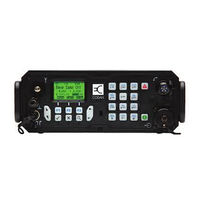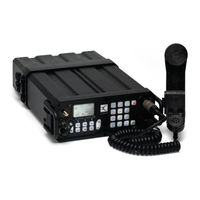Codan 2110 series Manuals
Manuals and User Guides for Codan 2110 series. We have 5 Codan 2110 series manuals available for free PDF download: Reference Manual, Repair Manual, Getting Started Manual
Codan 2110 series Reference Manual (521 pages)
Manpack Transceiver
Brand: Codan
|
Category: Transceiver
|
Size: 9.8 MB
Table of Contents
-
-
Definitions20
-
-
-
-
Quick Start94
-
Using Hot Keys113
-
-
Automatic Tuning114
-
Manual Tuning115
-
-
7 Using Lists
120-
The Main Menu120
-
Selecting a List122
-
The List Manager123
-
Setting a Marker126
-
-
-
About Networks158
-
-
10 The NET List
172 -
-
-
Address Syntax202
-
Call Types209
-
Emergency Call211
-
Message Call212
-
Selective Call213
-
Making a Call218
-
Calling Methods226
-
Receiving a Call235
-
The Calls in Log237
-
-
ALE Entries257
-
Devices Entry267
-
GPS Screen Entry275
-
LQA Screen Entry279
-
Messages Entry280
-
Welcome Text283
-
16 The Mode List
287 -
-
Overview324
-
-
-
Overview330
-
-
22 Hot Keys
354-
About Hot Keys354
-
Storing Macros356
-
Copying a Macro360
-
Moving a Macro361
-
Renaming a Macro362
-
Deleting a Macro362
-
Special Macros365
-
-
23 Connectors
367-
Front Panel368
-
Connectors368
-
Back Panel374
-
Battery Pack375
-
-
-
-
-
-
About CICS420
-
-
-
Using CICS420
-
Setting up CICS427
-
CICS Commands429
-
Alecall Command432
-
Amd Command434
-
Beacon Command435
-
Call Command436
-
Chan Command437
-
Echo Command438
-
Freq Command439
-
Hangup Command441
-
Help Command442
-
Lbt Command442
-
Link Command443
-
Lock Command443
-
Lqa Command444
-
Mode Command445
-
Mute Command445
-
Pagecall Command446
-
Prompt Command447
-
Ptt Command448
-
Scan Command449
-
Secure Command450
-
Selcall Command453
-
Selfid Command454
-
Set Command455
-
Sideband Command456
-
Sound Command457
-
Telcall Command461
-
Ver Command461
-
-
-
Introduction484
-
-
-
Introduction506
-
FCC Compliance509
-
C-Tick Approval509
-
-
Index
511
Advertisement
Codan 2110 series Repair Manual (164 pages)
Manpack Transceiver
Brand: Codan
|
Category: Transceiver
|
Size: 5.86 MB
Table of Contents
-
Index11
-
Introduction15
-
Disposal16
-
Overview23
-
General24
-
Connectors25
-
Front Panel25
-
Back Panel30
-
Battery Pack32
-
Receive Path39
-
General87
-
Transmit Tests100
-
Adjustments111
-
Adjusting the PA111
-
Flowcharts125
-
Definitions152
-
Glossary154
-
Units156
-
Unit Multipliers156
-
About this Issue157
-
Specifications159
-
General159
-
Receiver161
-
Transmitter162
-
Antenna Tuner163
-
GPS Connector163
Codan 2110 series Reference Manual (142 pages)
SSB
Brand: Codan
|
Category: Transceiver
|
Size: 3.04 MB
Table of Contents
-
-
Definitions16
-
-
-
Quick Start69
-
-
The Main Menu100
-
Selecting a List102
-
The List Manager103
-
Setting a Marker106
-
Advertisement
Codan 2110 series Getting Started Manual (101 pages)
Manpack Transceiver
Brand: Codan
|
Category: Transceiver
|
Size: 1.3 MB
Table of Contents
Codan 2110 series Getting Started Manual (90 pages)
HF Radio Communications SSB Transceiver
Brand: Codan
|
Category: Transceiver
|
Size: 1.16 MB
Table of Contents
-
Introduction14
-
Directive15
-
Overview33
-
Hot Keys36
-
The Handset41
-
Glossary78
-
Units82
Advertisement




